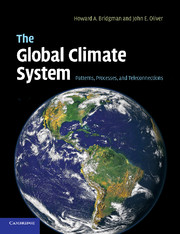Book contents
- Frontmatter
- Contents
- List of contributors
- Preface
- List of abbreviations
- 1 Introduction
- 2 Oscillations and teleconnections
- 3 Tropical climates
- 4 Middle-latitude climates
- 5 Climate of the polar realms
- 6 Post-glacial climatic change and variability
- 7 Urban impacts on climate
- 8 Human response to climate change
- 9 ESSAY: Model interpretation of climate signals: an application to Asian monsoon climate (Lau)
- 10 Conclusions and the future of climate research
- Other books on climatology and the climate system
- Index
- Plate section
- References
9 - ESSAY: Model interpretation of climate signals: an application to Asian monsoon climate (Lau)
an application to the Asian monsoon climate
Published online by Cambridge University Press: 05 June 2012
- Frontmatter
- Contents
- List of contributors
- Preface
- List of abbreviations
- 1 Introduction
- 2 Oscillations and teleconnections
- 3 Tropical climates
- 4 Middle-latitude climates
- 5 Climate of the polar realms
- 6 Post-glacial climatic change and variability
- 7 Urban impacts on climate
- 8 Human response to climate change
- 9 ESSAY: Model interpretation of climate signals: an application to Asian monsoon climate (Lau)
- 10 Conclusions and the future of climate research
- Other books on climatology and the climate system
- Index
- Plate section
- References
Summary
Introduction
Numerical modeling is a powerful tool to provide better understanding of the modus operandi, and the prediction of the Earth's climate system. However, a climate model's usefulness is limited by its crude representations of physical processes, most of which we do not understand very well. Since models are only crude approximations of the real system, model results must be validated against observations to ensure reliability. The scarcity of detailed observations for climate processes with the high spatial and temporal resolutions needed for model validation and improvement has been a major impediment for advancement in climate model simulation capability and model predictions.
Climate modeling is an attempt to mimic the evolution of the real climate states, which are described by a vast set of long-term global and regional observations in the atmosphere, ocean and land, from both in situ and satellite observations. Given that there are large uncertainties both in observations and in models, and that even the best model is simply a crude approximation of the real world, models and observations should be used in a synergistic manner for better understanding and for improved prediction. The relationship between observations, climate models, data assimilation, process studies, and climate predictions is shown schematically in Figure 9.1. A climate model consists of a dynamical core represented by governing equations of climate state variables, and physics modules of varying complexity (see next section for further discussion). […]
- Type
- Chapter
- Information
- The Global Climate SystemPatterns, Processes, and Teleconnections, pp. 281 - 308Publisher: Cambridge University PressPrint publication year: 2006
References
- 1
- Cited by



